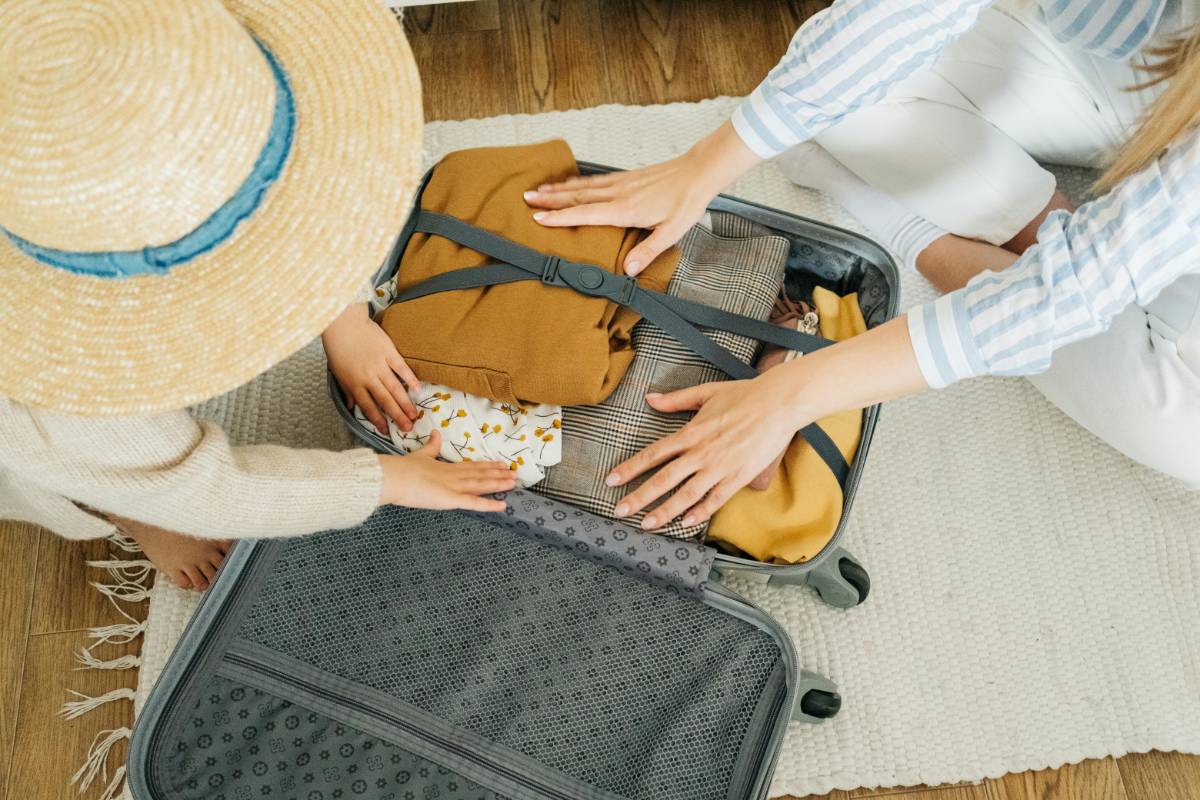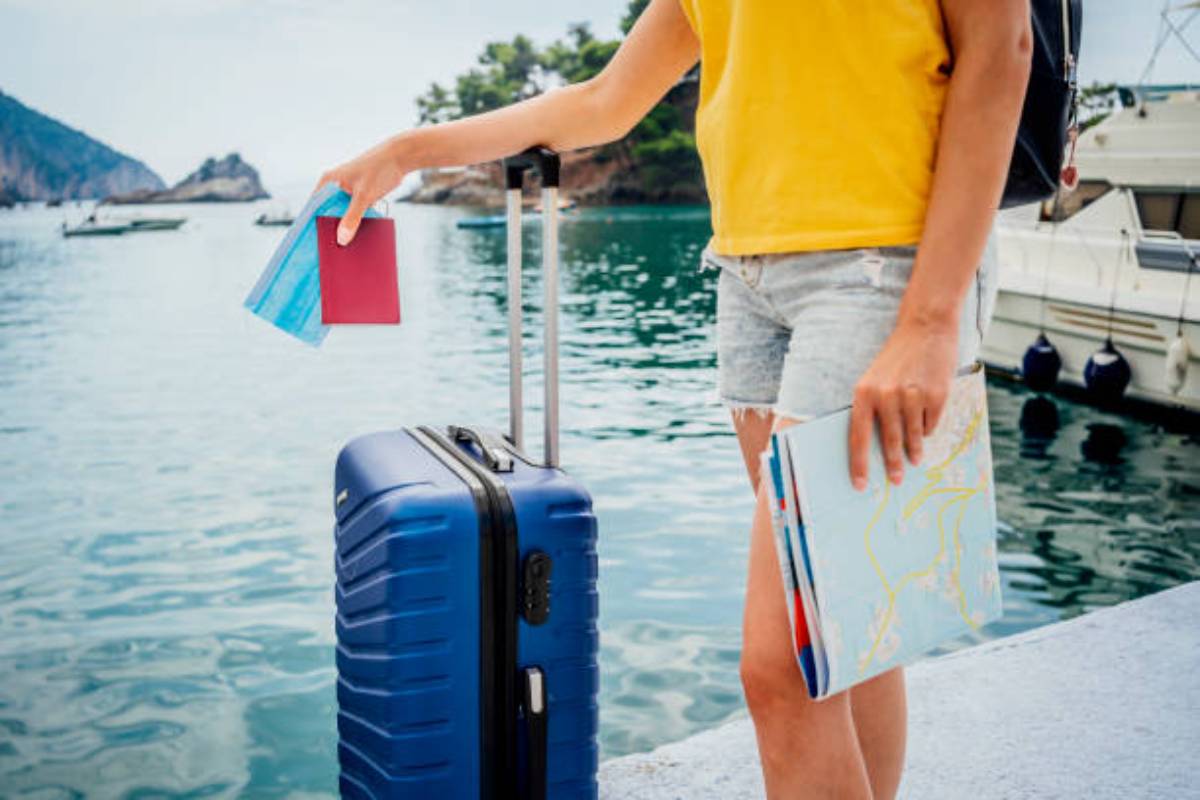
Traveling with kids can be a fun and rewarding experience, but it also requires extra planning and preparation. With a little strategy and creativity, you can ensure that your trip goes smoothly for the whole family. Here are some valuable tips for traveling with children of all ages, ensuring a seamless travel experience that everyone will remember fondly.
 Planning and Preparation are Key
Planning and Preparation are KeyOne of the most important aspects of traveling with kids is advanced planning. Begin by researching your destination thoroughly. Look into kid-friendly accommodations, such as hotels with pools, family suites, or places with kitchenettes where you can prepare simple meals. Additionally, check out local attractions and events that are suitable for children to ensure everyone has an enjoyable experience.
Planning your journey also involves determining the best mode of travel. Depending on the distance and your children’s ages, flying might be the best option, or you could opt for a road trip if you prefer flexibility. When flying, check out airlines that provide extra comfort for families, like kid-friendly amenities, priority boarding, and free entertainment.
Packing the EssentialsWhen traveling with children, packing efficiently is crucial. Be sure to bring all the necessities like clothing, toiletries, and any medical supplies, but don't forget the comfort items that will help your child feel secure. This could include a favorite blanket, a stuffed animal, or any other item that will make them feel at ease during the journey.
Consider packing snacks and drinks that your kids enjoy, but also those that will keep them full and energized. Snacks like granola bars, fruit, or crackers are great for long flights or road trips. If your child is still young, bring baby food or formula. Don’t forget a portable water bottle to keep them hydrated, and consider bringing a few healthy snacks that are easy to pack but nutritious.
Make sure to pack extra clothing for your child in case of accidents. Long flights, car rides, or unpredictable weather can lead to messy situations, so it’s always a good idea to be prepared with a fresh set of clothes. For parents of infants or toddlers, packing extra diapers, wipes, and a changing mat is essential.
Traveling with young children can be challenging, especially during long periods of waiting or long journeys. Keeping them entertained is key to a smooth trip. For toddlers and young kids, bringing their favorite toys, books, or games can help pass the time. Simple toys like blocks, action figures, or dolls are easy to carry and can be fun for kids throughout the trip.
For older children, electronic devices such as tablets, e-readers, or portable gaming systems are fantastic travel companions. Download their favorite apps, games, movies, or TV shows before the trip to ensure they have plenty of options to choose from. Just be sure to pack headphones to keep the noise to a minimum and avoid disturbing other passengers during flights or car rides.

Another great way to keep kids engaged during travel is by turning the journey into a fun experience. Road trip games like “I Spy,” scavenger hunts, or trivia games are excellent for getting everyone involved. If you’re flying, apps like SkyKids offer a range of child-friendly entertainment options during the flight.
When you’re traveling with kids, maintaining some semblance of their daily routine can help reduce stress. While it’s important to adapt to new surroundings, try to stick to regular meal times and nap schedules. Kids thrive on consistency, so if they’re used to eating at a certain time or taking an afternoon nap, try to stick to that as much as possible during your travels.
While on vacation, keeping your child's bedtime routine can also help them feel more secure and prevent meltdowns. You might not be able to fully recreate their usual environment, but familiar items like a nightlight, bedtime story, or music playlist can go a long way in easing them into their temporary surroundings.
Expect the UnexpectedEven the best-laid travel plans can encounter unforeseen bumps in the road. Whether it’s a delayed flight, an upset stomach, or an unexpected change in plans, things won’t always go according to the itinerary. This is why flexibility and patience are key when traveling with kids.
Before you leave for your trip, ensure you have the necessary emergency contacts, health insurance information, and travel documents readily accessible. It’s also wise to know where the nearest medical facilities are in case of emergencies, particularly when traveling abroad or to unfamiliar locations.
Bring a well-stocked first-aid kit that includes essentials like band-aids, pain relievers, anti-nausea medication, and any prescribed medication your child may need. Be sure to check with your pediatrician if your child requires any special travel recommendations or health precautions before your trip.
The Power of Positive ReinforcementTraveling with kids is a learning experience for everyone involved. Celebrate small successes along the way, whether it’s handling a long flight without a tantrum or behaving well during a long car ride. Positive reinforcement, like praise, small rewards, or giving them a sense of accomplishment, can encourage your kids to handle the trip better.
This also extends to your kids' involvement in trip planning. Allow them to choose certain activities or restaurants they’d like to experience during the trip. This sense of ownership in the trip’s outcome can make them more excited and engaged throughout the journey.
Dealing with Travel FatigueTravel fatigue is a reality, especially for young kids. Long days of sightseeing or extended travel times can wear down even the most energetic child. Be mindful of your children’s needs and make sure to plan downtime during your trip. Whether it’s a short nap in the hotel room or some quiet time at the park, rest is essential for maintaining energy levels and preventing frustration or over-stimulation.
Make sure to include some relaxed, low-energy activities in your itinerary. Visiting a local museum, enjoying a leisurely walk through a park, or simply spending time in a quiet café can be a welcome break from the hustle and bustle of sightseeing.
Conclusion: Making Family Travel a SuccessTraveling with kids doesn’t have to be a stressful experience. With proper planning, the right attitude, and some patience, your family can enjoy a smooth and fun-filled journey. From packing the essentials to keeping kids entertained and engaged, these tips will help ensure that your family travels are enjoyable for everyone involved. Above all, remember that the journey itself can be just as rewarding as the destination when you approach it as an adventure the whole family can enjoy together.
The best of Business news, in your inbox.

Legal Strategist & Thought Leader
Stefen brings a strategic legal mindset with a passion for translating legal complexities into digestible insights. Their articles reflect a deep understanding of justice, rights, and reform.
Read more from Stefen
In today's fast-paced world, where most people rush through their travel experiences, slow travel offers a refreshing approach. Slow travel encourages you to take your time, immerse yourself in the local culture, and savor every moment of your journey. By focusing on quality over quantity, slow travel allows you to create meaningful, memorable experiences. Here’s how you can embrace the art of slow travel on your next trip.1323a.jpg***Choose a Single DestinationOne of the key principles of slow travel is focusing on one destination rather than trying to see multiple places in a short amount of time. Instead of hopping from one city to another, spend several days (or even weeks) in one location to really get to know the area.By choosing a single destination, you have the opportunity to explore it deeply. Visit local landmarks, try different eateries, interact with residents, and discover hidden gems off the beaten path. This approach allows you to experience a place in a more authentic and fulfilling way.***Travel Slowly Between LocationsIf you do want to visit multiple destinations, take your time getting between them. Instead of booking the fastest mode of transportation, consider taking a train, bus, or road trip. These slower modes of travel not only offer scenic views but also allow you to experience the journey itself, rather than just rushing to the next destination.Taking a slow journey allows you to see more of the countryside, interact with locals along the way, and enjoy the process of travel itself. Plan for longer travel days to make the most of these slower routes.***Embrace Local CultureSlow travel is about connecting with the local culture and immersing yourself in the community. Take time to learn about the history, customs, and traditions of the place you are visiting. Attend local festivals, try regional foods, or participate in cultural workshops.By embracing the culture, you gain a deeper understanding of the place and its people. It also helps you step away from the typical tourist experience and see the destination through a more authentic lens.1323b.jpg***Stay in Local AccommodationsInstead of staying in large chain hotels, consider booking accommodations that are locally owned, such as guesthouses, boutique hotels, or Airbnb rentals. These types of accommodations often provide a more intimate and personal experience, as the owners can offer insider tips and recommendations that you wouldn't find in a guidebook.Local accommodations also give you the opportunity to support small businesses and experience the destination like a local. You’ll often find these types of places in quieter neighborhoods, allowing you to experience the rhythm of daily life away from the tourist crowds.***Unplug and DisconnectOne of the core principles of slow travel is the idea of disconnecting from the hustle and bustle of modern life. When traveling slowly, take the time to unplug from your devices and immerse yourself fully in the experience.Turn off your phone notifications, avoid spending too much time on social media, and embrace the present moment. This allows you to be more mindful of your surroundings and the people you encounter along the way.***Pace YourselfOne of the challenges of modern travel is the temptation to over-schedule. On a slow travel journey, it’s important to resist the urge to fill every moment with activities. Instead, prioritize quality over quantity and allow yourself time to relax and take things at your own pace.Take breaks when you need them, and give yourself permission to just sit in a café, people-watch, or wander aimlessly through a neighborhood. Slow travel is about savoring the journey, not rushing through it.***Enjoy SpontaneityWhile planning is important, slow travel also allows room for spontaneity. Sometimes the best experiences come from unplanned moments—discovering a hidden alleyway, stumbling upon a local market, or meeting a friendly local who offers to show you around.Allow yourself to follow your instincts and embrace these spontaneous moments, as they often lead to the most memorable parts of your journey.***Reflect and Disconnect at the End of Each DayAt the end of each day, take some time to reflect on what you’ve experienced. Slow travel encourages mindfulness, and taking a few moments to digest the day’s adventures can help you process your journey more fully.Whether you keep a travel journal, meditate, or simply enjoy a quiet moment with a cup of tea, reflecting at the end of each day allows you to truly appreciate the experiences you’ve had and makes your travel more meaningful.***ConclusionThe art of slow travel is all about savoring the journey rather than rushing to check off items on a list. By slowing down, immersing yourself in the local culture, and allowing room for spontaneity, you can create richer and more memorable travel experiences. The next time you travel, remember to slow down and enjoy every moment.

Travel insurance is an essential consideration when planning any trip, as it provides financial protection in case of unexpected events, such as trip cancellations, medical emergencies, or lost luggage. With so many travel insurance options available, it can be challenging to determine which policy best suits your needs. Here’s a guide to help you choose the best travel insurance for your trip.1309a.jpg***Assess Your Coverage NeedsThe first step in choosing the right travel insurance is to assess your needs. Consider the following factors to determine the type and amount of coverage you need:Trip Length: The longer your trip, the more coverage you may need, especially for medical expenses and evacuation.Destination: Some countries have high medical costs or specific travel risks that require additional coverage, such as coverage for extreme sports or natural disasters.Health Conditions: If you have pre-existing health conditions, look for a policy that covers them or offers medical evacuation if necessary.Travel Activities: If you plan on participating in activities such as hiking, skiing, or scuba diving, check that your insurance covers these activities.Budget: While it's important to have comprehensive coverage, you also want to make sure the policy fits your travel budget. Compare options to find a balance between cost and coverage.1309b.jpg***Understand the Types of CoverageTravel insurance policies typically offer several types of coverage, and understanding these can help you make an informed decision:Trip Cancellation: This coverage reimburses you for non-refundable trip expenses if you need to cancel your trip for a covered reason (e.g., illness, injury, or death in the family).Medical and Emergency Coverage: This is crucial for international travelers, as medical care can be expensive abroad. Ensure the policy covers emergency medical treatment, hospitalization, and evacuation if needed.Baggage and Personal Belongings: This coverage reimburses you for lost, damaged, or stolen luggage and personal items during your trip.Travel Delay and Missed Connection: If you miss a flight connection or experience delays that result in additional expenses, this coverage can help reimburse you for meals, accommodations, and transportation.Emergency Evacuation: This coverage is especially important for travelers going to remote areas. It covers the cost of getting you to a medical facility in case of a serious injury or illness.***Check the Policy ExclusionsNo travel insurance policy covers everything, so it’s essential to read the exclusions carefully. Common exclusions include:Pre-existing medical conditions: Many policies do not cover medical expenses related to pre-existing conditions unless specifically stated.High-risk activities: Activities like skydiving, bungee jumping, or mountaineering might not be covered under a standard policy. You may need to purchase additional coverage for these activities.Natural disasters: Some policies may not cover cancellations or delays caused by natural disasters, so make sure you're aware of these potential exclusions.War or civil unrest: Some policies exclude coverage for events related to war, terrorism, or civil unrest.***Evaluate the Insurance ProviderChoosing a reputable and reliable insurance provider is just as important as choosing the right policy. Look for the following when evaluating insurance companies:Customer service: Check reviews and ratings of the provider's customer service, especially when it comes to claims handling. Look for companies with 24/7 assistance available for emergencies.Financial stability: A financially stable company is more likely to be able to pay out claims when needed. Check ratings from agencies like A.M. Best or Standard & Poor’s to evaluate the provider’s financial health.Claims process: Investigate the claims process to ensure it is straightforward and efficient. Some insurers offer mobile apps that allow you to submit claims quickly while on your trip.***Compare Policies and PricesOnce you’ve determined the type of coverage you need and identified potential providers, it’s time to compare policies and prices. Use comparison websites or consult with a travel insurance broker to see what’s available for your trip. Keep in mind that the cheapest option may not always provide the best coverage, so make sure to review each policy’s terms and conditions carefully.***ConclusionChoosing the best travel insurance for your trip involves assessing your needs, understanding the coverage options, checking exclusions, and selecting a reputable provider. With the right policy in place, you can enjoy peace of mind knowing you're protected against the unexpected.

Traveling by air can be one of the most expensive parts of a trip, but with a little bit of planning and strategy, you can significantly reduce the cost of your airfare. Whether you're planning a weekend getaway or an international adventure, there are several insider tips that can help you save money and score the best deals. Here are some expert tips to help budget travelers save on airfare.1303a.jpg***Book Early (But Not Too Early)One of the most common pieces of advice for saving on airfare is to book early. While booking in advance can often result in lower prices, there’s a sweet spot to aim for. For domestic flights, the best time to book is typically 1-3 months before departure. For international flights, try to book 2-6 months in advance. Booking too far in advance or waiting until the last minute can lead to higher prices.Try to avoid booking flights too early or too late, as both can be costly. Track flight prices over time to identify the best time to book.***Be Flexible with Your Travel DatesFlexibility is key when trying to save on airfare. Flights can vary dramatically in price depending on the day of the week, time of day, and time of year. Typically, mid-week flights (Tuesday, Wednesday, and Thursday) are less expensive than weekend flights, as fewer people travel on those days.Consider traveling during off-peak seasons. Avoid popular vacation times like summer, holidays, and school breaks. Flying in the shoulder season or off-season can result in significantly cheaper fares.***Use Fare Comparison Websites and AppsTo find the best airfare deals, use fare comparison websites and apps like Google Flights, Skyscanner, and Kayak. These platforms allow you to compare prices across different airlines and booking sites, helping you find the lowest price available for your chosen route.Set up fare alerts to be notified when prices drop for your desired flight. Many sites and apps offer this feature, allowing you to track fluctuations in ticket prices and book when the price is right.1303b.jpg***Consider Nearby AirportsWhen searching for flights, don’t limit yourself to just the main airport in your destination city. Many major cities have multiple airports, and flying into or out of a secondary airport can save you money. Be sure to factor in transportation costs to and from the airport when considering this option.For example, if you’re flying into New York City, check flights to airports like LaGuardia, JFK, or Newark. A flight into one airport may be cheaper, even after accounting for the cost of ground transportation to your accommodation.***Fly on Budget AirlinesBudget airlines like Southwest, Ryanair, and Spirit often offer significantly cheaper fares compared to traditional carriers. While these airlines may charge for extras like checked luggage, seat selection, and snacks, they can still be a cost-effective option for budget-conscious travelers.Keep an eye out for flash sales and promotions from budget airlines. Signing up for their email newsletters or following them on social media can help you stay informed about special deals and discounts.***Use Airline Miles and PointsIf you’re a frequent traveler, using airline miles or credit card points can be a great way to save on airfare. Many credit cards offer travel rewards that can be redeemed for flights, hotel stays, and more.Sign up for frequent flyer programs with airlines to accumulate miles that can be redeemed for future flights. Even if you don’t fly often, you can still take advantage of credit card reward programs to earn points toward flights.***Book Connecting Flights Instead of NonstopNonstop flights are often more convenient, but they can also be more expensive. If you're willing to add a little extra time to your trip, consider booking a connecting flight instead of a direct route. Connecting flights can be cheaper, especially if you have flexibility with your travel time and destinations.Check different layover options to find the best deals, but be mindful of long layovers that could add unnecessary time to your journey.***Check for Deals on Social MediaMany airlines and travel companies post exclusive deals and discounts on their social media channels. Follow airlines, travel agencies, and deal sites like Secret Flying or The Flight Deal to catch flash sales and promotions that might not be advertised on fare comparison websites.Social media platforms are also a great way to stay updated on last-minute sales and special offers from airlines.***Be Aware of Hidden FeesWhile a flight might look like a great deal at first glance, make sure to factor in all potential fees. Budget airlines and even some major carriers often charge additional fees for baggage, seat selection, and other services. Be sure to read the fine print before booking to avoid unexpected costs.Consider whether you need checked luggage or if you can make do with just a carry-on. If you're traveling light, you can save money by avoiding checked baggage fees.***ConclusionSaving on airfare doesn’t have to be difficult. By using these insider tips—booking at the right time, being flexible with your travel dates, comparing prices across multiple platforms, and using rewards points—you can save significant amounts on your flight tickets. With a little planning, you can fly to your next destination without breaking the bank!

For wine lovers, there's nothing better than combining travel with the discovery of exquisite vineyards. From the rolling hills of Tuscany to the sun-drenched valleys of California, the world’s best wine regions offer an unforgettable experience. Here are some of the top vineyard destinations to visit around the world.1321a.jpg***Bordeaux, France: The Heart of French Wine CountryBordeaux is synonymous with fine wine, offering a landscape dotted with vineyards and charming châteaux. Known for its red wine blends, Bordeaux has been producing wine for centuries. The region is home to some of the most famous wine estates in the world, such as Château Margaux and Château Lafite Rothschild.Bordeaux’s wine tours offer the chance to taste world-renowned wines, while also experiencing the picturesque French countryside, medieval towns, and fine dining.***Napa Valley, USA: America's Premier Wine RegionLocated in California, Napa Valley is one of the most popular wine regions in the United States. Known for its rich reds, particularly Cabernet Sauvignon, Napa is a place where wine lovers can enjoy both high-end wineries and casual tasting rooms. The scenic vineyards set against the backdrop of the Mayacamas Mountains make Napa a stunning place to visit.Napa Valley offers year-round wine festivals, and visitors can take part in guided wine tours, cooking classes, and even vineyard bike rides. The region’s Mediterranean climate makes it ideal for wine production.***Tuscany, Italy: A Blend of History and WineTuscany is a dream destination for wine enthusiasts. The rolling hills, historic villages, and famous vineyards create a picturesque backdrop for a wine-focused vacation. Tuscany’s Chianti region is famous for its Sangiovese wines, but the region also produces a variety of reds and whites.You can visit vineyards that have been around for centuries, enjoy wine tastings with local food pairings, and explore the beautiful Tuscan countryside. Don’t miss a visit to the iconic medieval town of San Gimignano and its wine cellars.1321b.jpg***Mendoza, Argentina: Wine in the AndesMendoza is Argentina’s most famous wine region, nestled at the foothills of the Andes. Known for its Malbec wines, Mendoza is a region that offers wine lovers an opportunity to explore high-altitude vineyards and enjoy spectacular views of the mountains. The region’s dry climate and abundant sunshine make it perfect for growing rich, full-bodied wines.In addition to wine tasting, Mendoza offers activities such as horse riding through the vineyards and exploring local wine museums. The combination of stunning natural beauty and world-class wine makes it a must-visit destination.***Rioja, Spain: Spain’s Premier Wine RegionRioja, located in northern Spain, is one of the country’s most famous wine regions. Known for its Tempranillo wines, Rioja offers visitors a chance to explore traditional wineries that have been making wine for generations. The region’s beautiful landscape, with vineyards stretching across the rolling hills and valleys, is perfect for a wine-themed getaway.In Rioja, you can visit historic wine cellars, sample a variety of wines, and learn about the unique aging process of Rioja wines. The region also offers fantastic cuisine, making it a perfect destination for food and wine lovers.***Cape Winelands, South Africa: A Hidden GemThe Cape Winelands of South Africa are quickly gaining recognition as one of the world’s top wine destinations. Just a short drive from Cape Town, the region is home to scenic vineyards, rolling hills, and charming towns such as Stellenbosch and Franschhoek. The area is known for its excellent Sauvignon Blanc, Chardonnay, and Pinotage wines.Cape Winelands offers a range of activities, from wine tastings to horseback riding through the vineyards, as well as gourmet restaurants that showcase the best of South African cuisine paired with local wines.***La Rioja, Chile: An Unforgettable Wine ExperienceLa Rioja in Chile is often compared to Bordeaux due to its exceptional wines and picturesque vineyards. Located at the base of the Andes mountains, this region is known for its smooth reds, particularly Carmenère and Cabernet Sauvignon. La Rioja offers breathtaking landscapes with its vineyards, mountains, and charming small towns.Visitors can enjoy private wine tours, explore the region’s artisanal wines, and relax at luxurious vineyard hotels with sweeping views of the Andes. La Rioja is perfect for those looking for an off-the-beaten-path wine experience.***Marlborough, New Zealand: A Cool-Climate Wine RegionMarlborough is New Zealand’s most famous wine region, known for its fresh and vibrant Sauvignon Blanc. Located on the South Island, Marlborough is characterized by its cool climate and long sunlight hours, creating the ideal conditions for aromatic white wines and Pinot Noir.Marlborough offers visitors a chance to take scenic bike tours through the vineyards, enjoy tastings at boutique wineries, and explore the nearby coastline. The region’s natural beauty, combined with its world-class wines, makes it an unforgettable destination.***Okanagan Valley, Canada: A Rising StarOkanagan Valley in British Columbia is an up-and-coming wine region known for its diverse wine production. With a growing number of wineries, the valley produces everything from ice wine to Chardonnay and Merlot. The area’s stunning scenery, with lakes, mountains, and vineyards, makes it a picturesque wine destination.Okanagan Valley is perfect for those looking for a more laid-back wine experience, with activities such as vineyard picnics, wine tasting tours, and boating on Okanagan Lake.***ConclusionWine and travel go hand in hand, offering a chance to explore the world’s most beautiful regions while indulging in some of the finest wines. Whether you're touring the iconic vineyards of Bordeaux, sipping Malbec in Mendoza, or discovering the hidden gems of South Africa, a wine-themed vacation promises to be both educational and unforgettable. Plan your next wine adventure to one of these top vineyard destinations and savor the experience.